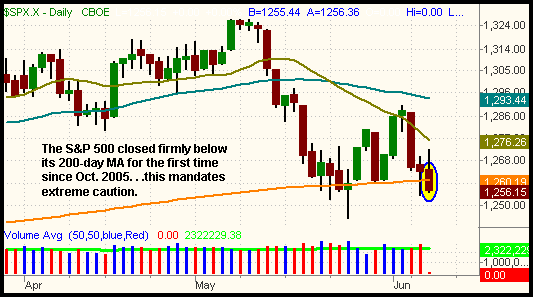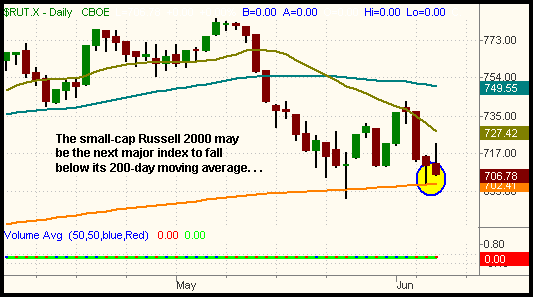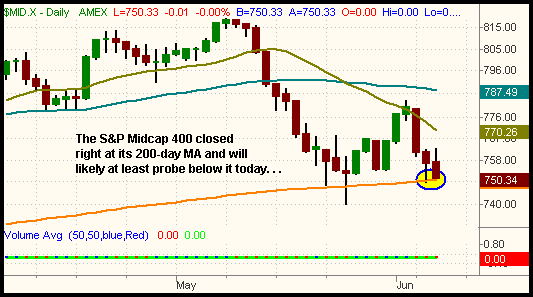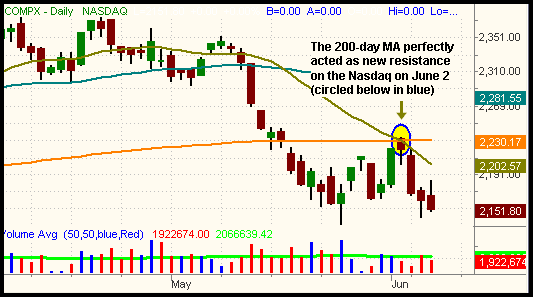Stocks attempted to rally after the S&P 500 bounced off its 200-day moving average for the third time, but the morning gains quickly dissolved as the bears took control in the afternoon. The S&P 500, which was trading 0.7% higher in the morning, finished with a 0.6% loss, as did both the Dow Jones Industrial Average and small-cap Russell 2000 indices. The Nasdaq Composite saw its intraday gain of 1% morph into a 0.5% closing loss. The S&P Midcap 400 Index fell 0.8%. Each of the major indices finished not only at their intraday lows, but at the lows of the prior day as well.
Turnover declined in yesterday's session, enabling the S&P and Nasdaq to dodge another "distribution day," but market internals were negative nevertheless. Total volume in the NYSE was 4% lighter than the previous day's level, while volume in the Nasdaq declined by 8%. In both exchanges, declining volume exceeded advancing volume by just over 2 to 1.
Yesterday's loss in the S&P 500 caused the index to close firmly below support of its 200-day moving average for the first time since October of 2005:

On May 23, the S&P closed fractionally below its 200-MA, but not by a wide enough margin to confirm a break of support. But this time, the break of the 200-MA is also confirmed by three failed rally attempts off of that support level. As we have been mentioned several times over the past week, the market action has the potential to get even more negative now that the S&P has broken its 200-MA. This is due largely to the fact that institutional sell programs often kick in when a major index falls below its 200-day moving average. If only one index was below its 200-day MA and the rest were strong, it would be less significant, but the problem is that all of the major indices are showing about the same amount of weakness and similar chart patterns. Notice how the small-cap Russell 2000 and the S&P Midcap 400 indices, both of which were leading the market before the selloff began, closed right at their 200-day MAs as well:


The Nasdaq Composite's action on June 2 was a great example of how a prior support level becomes the new resistance level after the support is broken. Unlike the S&P, which broke its 200-day MA only yesterday, the Nasdaq has been trading below its 200-MA since May 17. Then, on June 2, the Nasdaq retracement off the lows perfectly stopped in its tracks due to resistance of the 200-MA. This shows how powerfully the 200-MA acts as a support/resistance level:

It doesn't take a nuclear physicist to figure out that now is a dangerous time to be long the equities markets. This, of course, has been the case for several weeks, but the situation could really worsen if the Russell 200 and S&P Midcap 400 indices crack their 200-MAs as well. More importantly than the chart patterns of the major indices is that there is no individual stock or sector leadership in the markets. A weak market always requires one or two sectors to begin outperforming and lead the rest of the market higher, but we are not seeing any clear leadership yet. Former high flying stocks have begun to break key trendlines and new breakout attempts are failing all over the place. These factors alone confirm that the market is not healthy and it is wrong to be long.
Deron Wagner is the Founder and Head Trader of both Morpheus Capital LP, a U.S. hedge fund, and Morpheus Trading Group, a trader education firm launched in 2001 that provides daily technical analysis of the leading ETFs and stocks. For a free trial to the full version of The Wagner Daily or to learn about Wagner's other services, visit MorpheusTrading.com or send an e-mail to deron@morpheustrading.com.